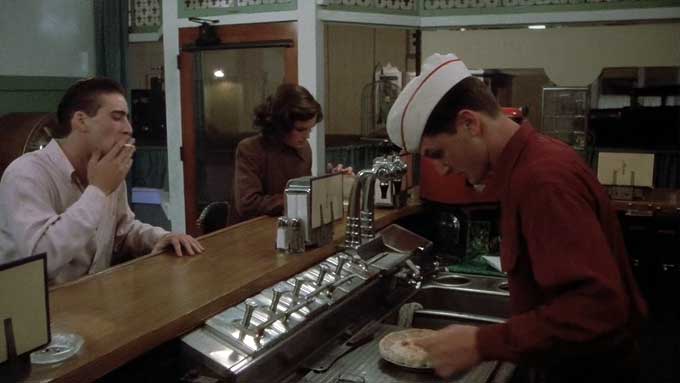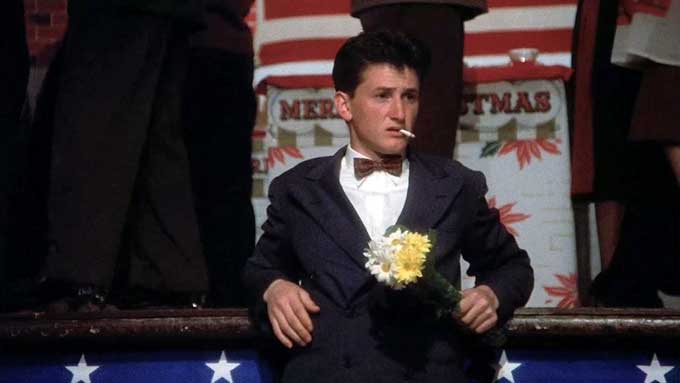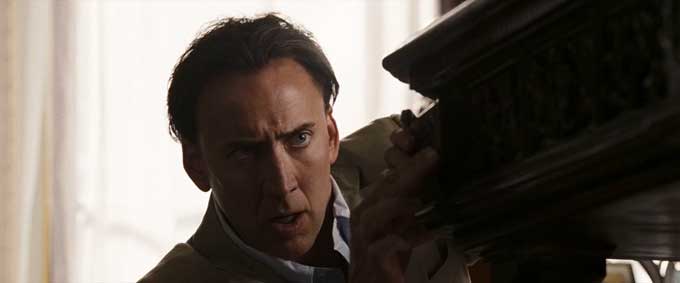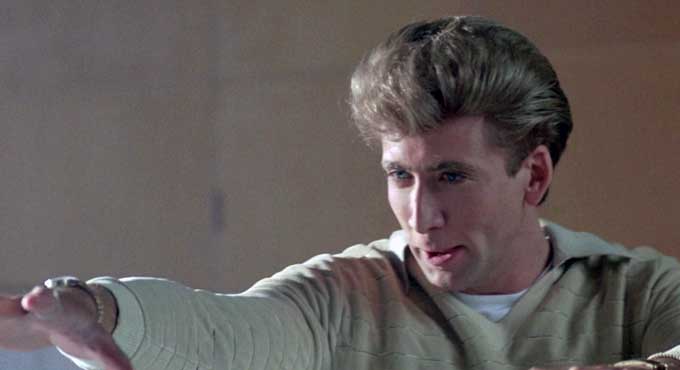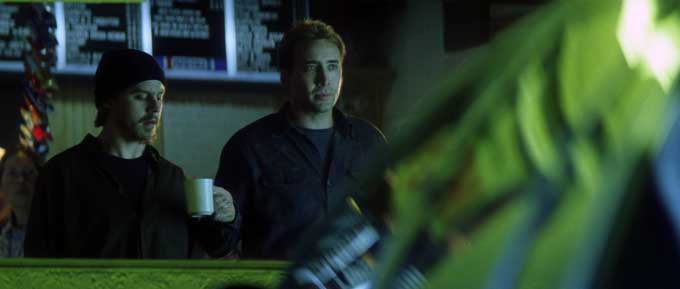Racing With the Moon (1984): Growing Up is the Hardest Thing to Do [Joey’s Review]
In RUMBLE FISH, we saw Cage circa the 1960s. In the next film we’re watching, THE COTTON CLUB, we’ll see 1920s-era Cage. Today, we bridge the gap with World War II era cage in RACING WITH THE MOON, which takes place over six weeks in 1942-1943 before Cage goes off to war.
Like RUMBLE FISH, Cage is not the star of this film. However, he is in a lot of it — and is far-and-away the most entertaining character in this film. The lead is Sean Penn (re-uniting with Cage after their roles together in FAST TIMES!), who’s soon to be headed off to War (with a capital W to emphasize its seriousness) with Cage. Penn falls in love with a girl named Caddie (played by Elizabeth McGovern, who will later appear with Cage in KICK-ASS), whom the boys believe is a Gatsby. You see, even though F. Scott Fitzgerald released The Great Gatsby in 1925, apparently kids in 1942 still refer to yuppies as Gatsbys. Whatever. I love it. Let’s embrace it.
While Penn is sort of a slacker, he’s not at all like his character Spicoli from Fast Times. In Racing, he plays Henry ‘Hopper’ Nash, a clean-cut kid who can play the piano and will shortly ship out to serve his country. Both Hopper and Spicoli have childlike senses of innocence, but there really couldn’t exist a person like Spicoli in 1942; the times were too different (which we’ll get to in a bit).
Penn works with Cage at a bowling alley. Cage plays a character named “Nicky”, which is the second time in five movies that he’s played a character that basically has his name. (Later on, he’ll say his name is “Bud”, which was effectively his name in Fast Times. COINCIDENCE? I THINK NOT!) This is where we’re introduced to Cage — he’s working as a bowling pin resetter, drinking hard liquor on the job. It looks like tiring work, but he also looks like he’s absolutely crushing it at his job:
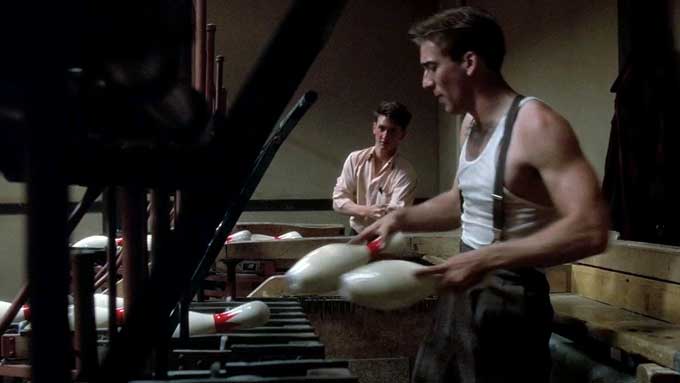
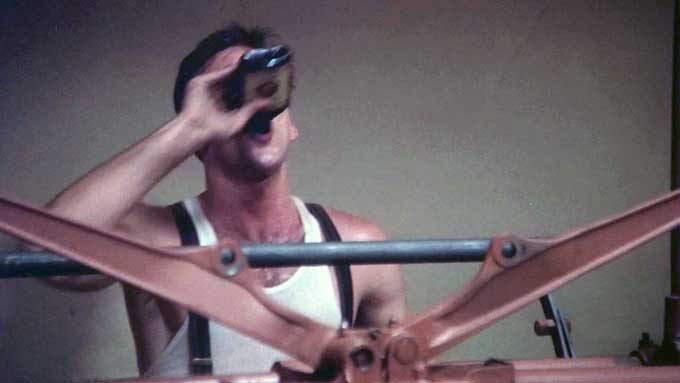
There’s another Cagenection to be found. Who’s bowling? Why, it’s none other than Crispin Glover! Yes, soon-to-be George McFly himself and Cage’s former best friend in THE BEST OF TIMES, Crispin Glover is credited only as “Gatsby Boy” and is the absolute worst. He keeps throwing bowling balls at Penn’s feet before he can get out of the way. He and his friends absolutely love the torture they’re putting these poor bastards through. Here, check out Glover’s smug smile when he’s bowling:
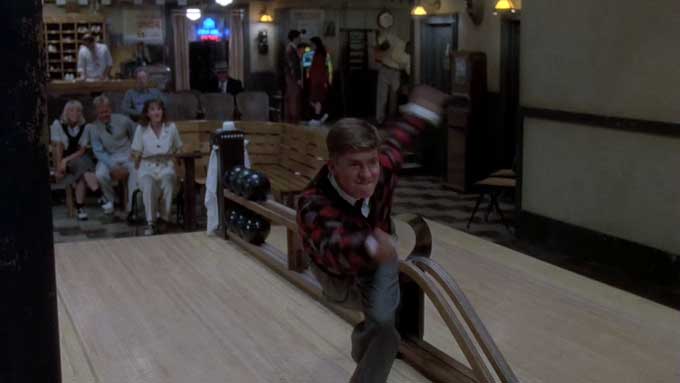
Hopper quickly has enough, and races over to deck Gatsby Boy. He punches him once in the face, which creates ALL THE BLOOD. Some of it gets on Gatsby Girl (Gatsby Boy’s date), but don’t worry — Cage is there to clean it up and lend a hand.
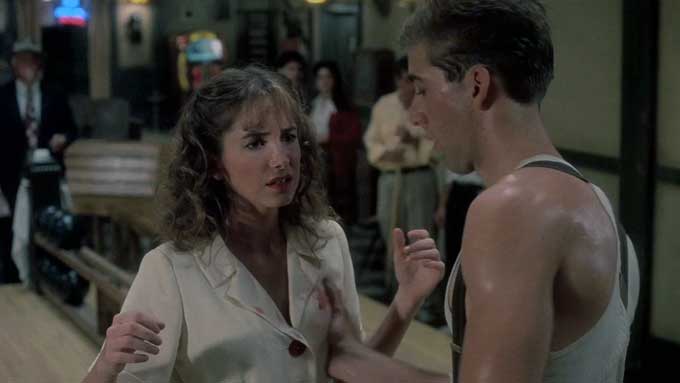
She’s so out of it she doesn’t complain. Cage, you sly devil.
Cage and Penn then go outside to water down some vodka. I have no idea what’s going on here, but it sets up a tone of hustling that continues throughout the movie:
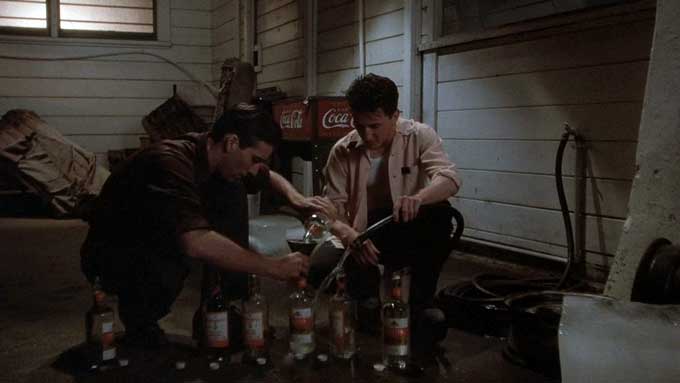
While watering it down, the two talk about how they’re fearful of headed off to war. It’s pretty much the only topic of conversation on the table throughout this movie; World War II looms large over everything, even when they’re just trying to enjoy a double date at the movies or a trip to the roller rink. It was a different time, and it’s unfathomable to me how anyone would be able to concentrate in school during December and January if you knew you were headed off overseas (likely to die?) in mid-February. It’s bananas.
I don’t have anything to say about Sean Penn’s dog Argus, other than he looks adorable in aviator goggles:
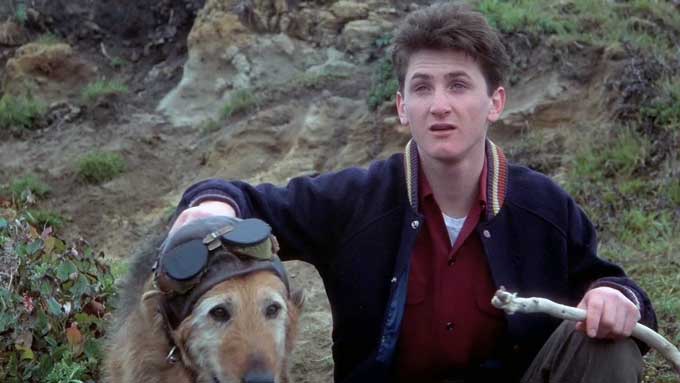
Nic Cage’s character is dating a girl who later gets pregnant and creates the film’s biggest conflict and tension. Sean Penn, meanwhile, falls hopelessly in love with Elizabeth McGovern’s character, Caddie, who works as a ticket taker at the town’s movie theater. While Penn and Cage are hanging out at the diner across the street from the theater, Penn sees Caddie headed for the diner, so he hops over the counter, “borrows” the passed out diner owner’s hat, and serves Caddie pie.
“What kind of pie do you have?” she asks.
“Uhhh… brown pie.” he responds.
“Alright,” she says, without hesitation. “I’ll have a piece.”
(If true love isn’t eating a piece of “brown pie,” I don’t know what is.)
I call this the Sean Penn Pie Plan. As far as I can tell, it has a 100% success rate. Granted, the sample size (of 1) is small, but you can’t argue with math.
When Hopper goes to cut up the pie and becomes utterly flummoxed by a cleaver, Nicky steps up to the counter to get a first-hand look at the action.
Cage then shows off one of my all-time favorite looks of enjoyment:
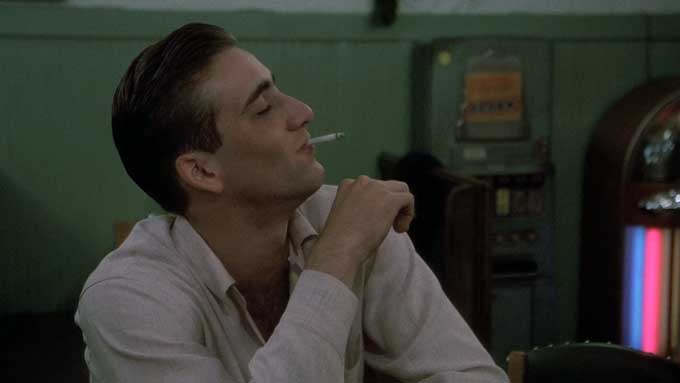
Ah, it’s good to see your friends make fools of themselves.
Caddie ducks out of the bar after getting her “brown pie,” and Hopper tears after her and skitches a ride on her bus to see where she lives. In a heartbreaking turn of events, he finds out that she lives in a massive house. “She’s a goddamned Gatsby,” Penn tells Cage, who shows up immediately after the bus leaves her house. (Why didn’t he just ask Nicky for a ride? I have no idea!)
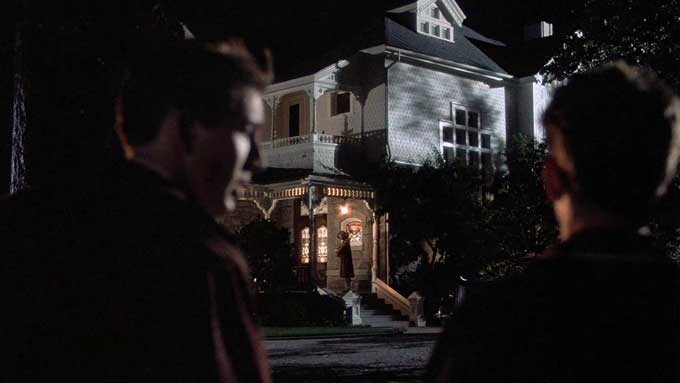
You may ask, “Why would a Gatsby work at a movie theater?” And that’s what Penn asks. Cage says simply, “Her dad probably owns it.” That’s a logical explanation… or is there something more here?
Sean Penn pops back into the diner a few days later (after getting smashed on the back by an old guy with a cane walking out, in one of my favorite unexplained bits of on-screen humor/aggression) and sees Caddie with her friend. He thinks Caddie’s asking him out, but it’s only to go on a double date with her friend. Womp womp. He still goes on the date, though, and kills it with his bow tie, cigarette, and bouquet of flowers look:
By the end of the night, it’s clear that Hopper and Caddie are the real pairing here, not her zero of a date or her mediocre friend. The two go on a couple more dates, then we follow Caddie home… AND FIND OUT SHE’S NOT A GATSBY AFTER ALL! Her mom is the maid at her gigantic house, and the two of them live there. What a twist! It’s conveyed in a terrific way, and helps propel action a little later in the film.
We then get to one of my two favorite sequences in the movie: Penn and Cage get piss-ass drunk on the roof of their bowling alley, then wander around to talk about war.
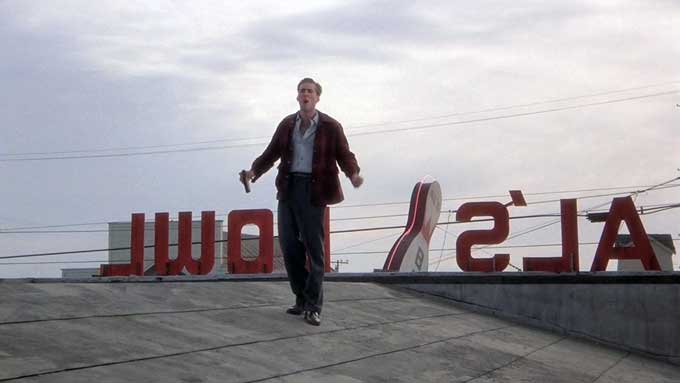
Sean Penn tells Cage he wishes he wouldn’t drink so much; Cage shoes him off, then does a little dance that he only learned how to do because he’s drunk. “Why would you want to do that?” Penn asks. “Because it gives me pleasure!” Here, look at his little jig:
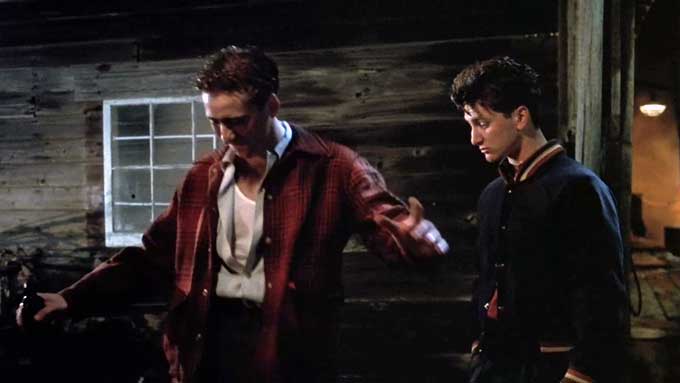
I can’t find video online, but here’s the audio from the scene. It’s wonderful:
The two then stumble into a tattoo parlor — that’s the “wowie!” part of their speech. Cage, who’s 20 years old at the time and totally ripped, lifts up his shirt — and keeps it up for the entire scene. It’s strange, but it totally fits, and he’s completely drunk.
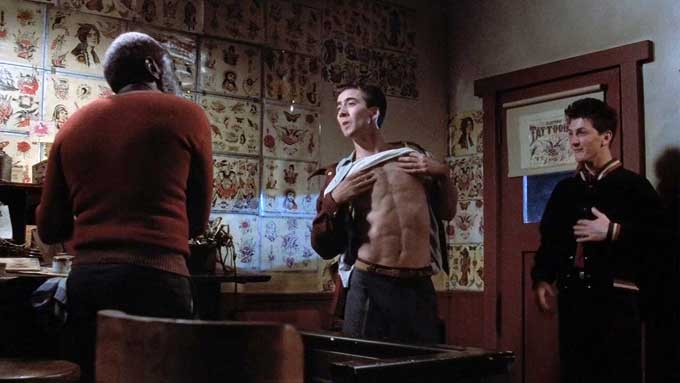
#CageAbs
After being refused a tattoo by the parlor owner, our two lovable dopes stumble off to the train tracks. It’s where the movie begins — Penn is walking down the tracks, reflecting on life — and where it ends — as the two go off to war. Now, though, they decide to play their “race the train” game; they stand on the tracks and wait until the train gets close. When it’s right up on them, they dive off, then run alongside, grab on, and hold on until they can’t hold any longer. It’s strange and dangerous, but it’s who they are, and it’s a reflection of the world at that time.
It’s the world at that time that leads to one of the most surreal scenes in the film. In a demonstration a la duck-and-cover drills, the entire high school participates in a “what would happen if we were attacked by Japan” drill. This poor kid was “shot all over”:
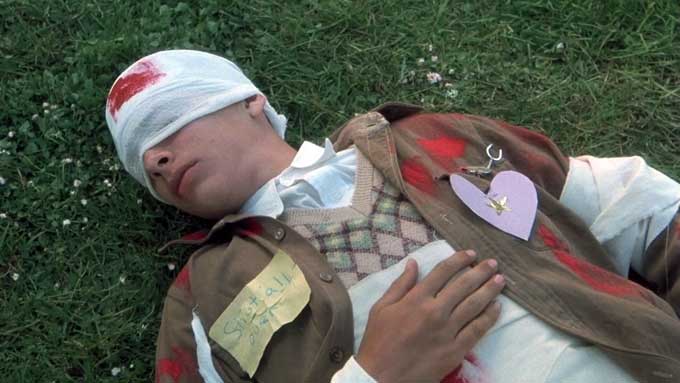
Cage, who’s unable to take anything seriously, goes in to kiss the nurse who stops by to heal him:
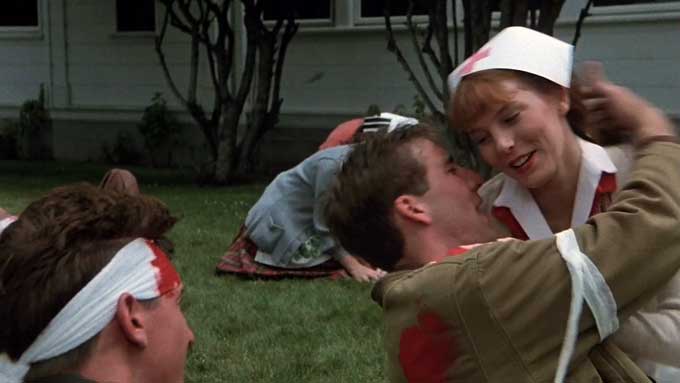
She laughs it off and walks away. Cage shouts after her: “Nurse, come back! I want to show you my wound!” Cage is then loaded onto a stretcher, and smacks every nurse he passes on the butt:
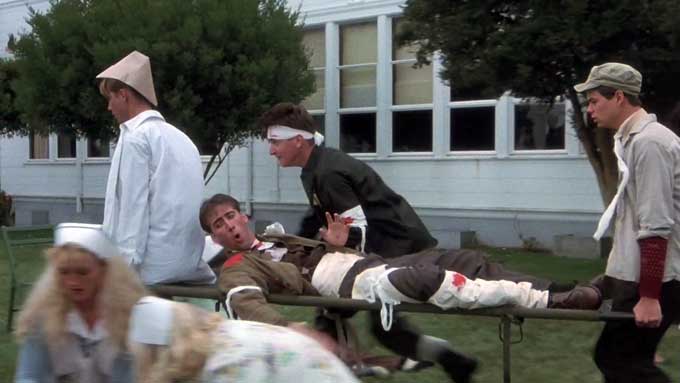
In perhaps the most surreal moment of any of the five Cage films we’ve watched so far (and that’s saying something, considering Rumble Fish is a black-and-white arthouse film), Cage and Penn change up the records from the sounds of war to a swing dance. This causes all the dead bodies, wounded students, and nurses to get up and start dancing. It’s wonderful and insane, all wrapped into a single package:
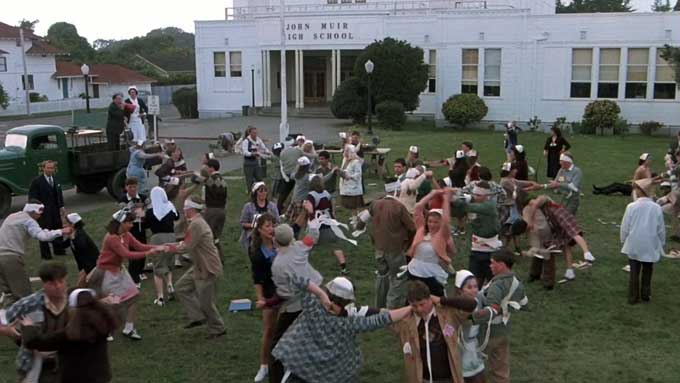
Cage’s character then receives some devastating news (for him, anyway): his girlfriend is pregnant and needs $150 for an abortion. It’s the second time in #CageClub (along with Fast Times) that an abortion has played such a pivotal role in the story. While Jennifer Jason Leigh’s character was able to go to an actual clinic, Cage’s girlfriend in this is forced to go to a terrifying makeshift abortion shack in the woods. It’s surprising that abortion is an option this far back, but equally terrifying that this is how the procedure is handled.
To get that $150, though, the two devise a plan: they’re going to re-enact their famous pool hustle. It’s the oldest trick in the book, which made me sad that the sailors they pull it on didn’t seem to catch on. Cage and Penn challenge them to a few games of pool for relatively low stakes. Toward the end, they ramp it up, and go for a $150 game. But in a delightful twist, the sailors were conning the two all along, too, and were far, far better at pool than they initially let on.
What follows is a beautifully-filmed scene that’s filled with cinematic tension. While the major tension points are cliché — Penn falls behind early, catches up, falls behind again, catches up again, then ultimately loses — it’s filmed in a way that makes the scene a joy to watch. Also, we get this great shot of irony/IDGAF attitude on Cage’s character’s behalf:
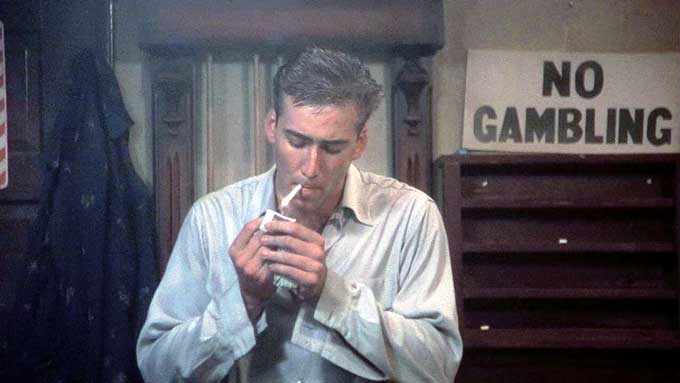
The sailors win, and the duo barely escapes with their livelihoods. They ask Caddie for $150, since she’s a Gatsby and all, except we know (and the duo soon finds out) she’s not. She’s able to borrow the money from the woman her mother works for, though, and Cage’s girlfriend gets an abortion. Consistent with his behavior throughout the film, Cage is unable to handle the situation, doesn’t assist his girlfriend in any way when walking to/from the clinic/her house, and instead opts to drown his sorrows in alcohol.
It’s this distinction that really differentiates him from Penn’s character. Both are in the same position; they’re both trying to enjoy their last six weeks before they head off to war. The only difference is that Penn seems fearful of war and hesitant to leave, while Cage lives life as though it’s a joke. This makes Cage’s on-screen actions more entertaining, but also telling — at his core, he’s a 20-or-so-year-old kid who’s terrified of the real world and doing whatever he can to escape his responsibilities. It’s too much too soon, and he’s not equipped to handle it.
Penn and his girlfriend break up after a lot of displaced anger, resentment, and worry, but ultimately get back together before the boys ship off to war. We talk about it on the podcast, but for a movie that pretty much nails its tone throughout, the ending plays out a little weird. The boys seem almost glad to go off to war, and it’s weird that the film portrays them leaving as a “happy ending.” It’s bizarre and sort of misses the mark, but doesn’t mar what’s otherwise a tremendously enjoyable and worthwhile film.
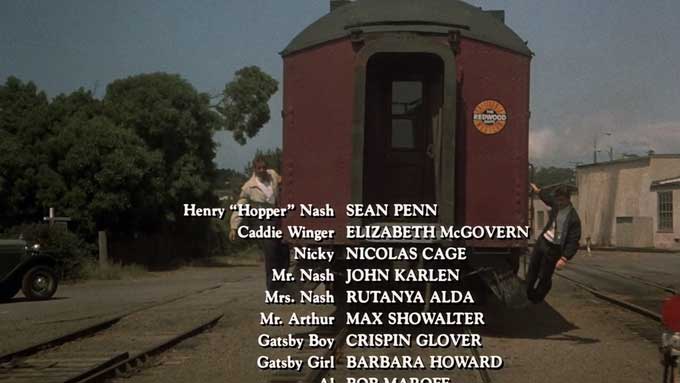
How can I watch it? It’s streaming on Netflix! You should turtlely check it out.
What’s up next? We continue our shuffle backwards in time to the 1920s and the Jazz Era with THE COTTON CLUB. It’s a Richard Gere movie, not a Cage starring role, and (again!) I know almost nothing about it. Check back tomorrow for our podcast about RACING WITH THE MOON, then the next day for our reviews of The Cotton Club!

